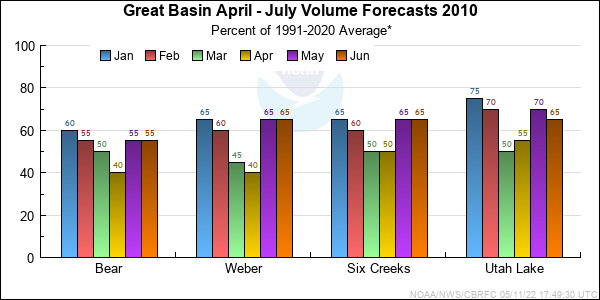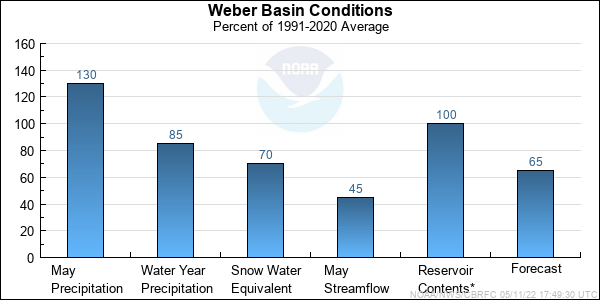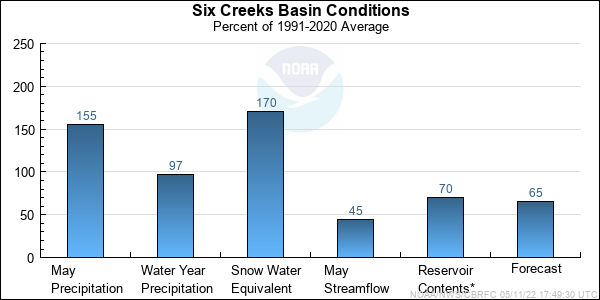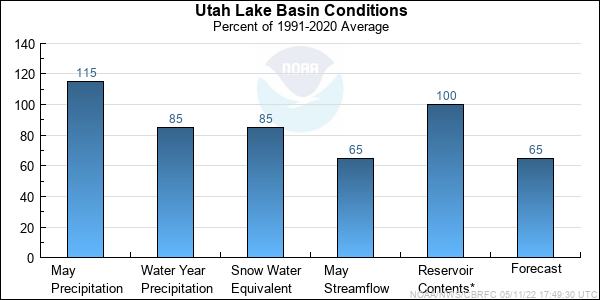
NOAA, National Weather Service
Colorado Basin River Forecast Center
Salt Lake City, Utah
www.cbrfc.noaa.gov
 | Prepared by B.Bernard NOAA, National Weather Service Colorado Basin River Forecast Center Salt Lake City, Utah www.cbrfc.noaa.gov |





| Forecast Period | 90% Exceedance Volume | 50% Exceedance Volume | Percent Average | 10% Exceedance Volume | |
| Bear | |||||
| Utah | April-July | 77 | 89 | 79 | 101 |
| June-July | 53 | 65 | 93 | 77 | |
| Woodruff Narrows Res * | April-July | 86 | 99 | 73 | 112 |
| June-July | 42 | 55 | 51 | 68 | |
| Montpelier, Nr, Stewart Dam, Blo * | April-July | 44 | 59 | 25 | 75 |
| June-July | 27 | 41 | 37 | 58 | |
| Big Ck | |||||
| Randolph, Nr | April-July | 0.9 | 2.2 | 46 | 5.8 |
| June-July | 0.45 | 1.4 | 65 | 3 | |
| Smiths Fork | |||||
| Border, Nr | April-July | 47 | 57 | 55 | 67 |
| June-July | 28 | 38 | 62 | 48 | |
| Logan | |||||
| Logan, Nr, State Dam, Abv | April-July | 63 | 70 | 56 | 77 |
| June-July | 36 | 43 | 61 | 50 | |
| Blacksmith Fork | |||||
| Hyrum, Nr, Upnl Dam, Abv | April-July | 22 | 24 | 50 | 26 |
| June-July | 10 | 12 | 60 | 14 | |
| Little Bear | |||||
| Paradise | April-July | 22 | 25 | 54 | 28 |
| June-July | 5 | 7.5 | 55 | 11 |
| Forecast Period | 90% Exceedance Volume | 50% Exceedance Volume | Percent Average | 10% Exceedance Volume | |
| Weber | |||||
| Oakley, Nr | April-July | 84 | 88 | 72 | 98 |
| June-July | 55 | 61 | 86 | 69 | |
| Rockport Res, Wanship, Nr | April-July | 71 | 87 | 65 | 103 |
| June-July | 45 | 61 | 85 | 77 | |
| Coalville, Nr | April-July | 75 | 89 | 64 | 103 |
| June-July | 44 | 58 | 83 | 72 | |
| Chalk Ck | |||||
| Coalville | April-July | 28 | 35 | 78 | 41 |
| June-July | 10 | 17 | 99 | 23 | |
| Weber | |||||
| Echo Res, Echo, At | April-July | 100 | 116 | 65 | 140 |
| June-July | 49 | 65 | 78 | 90 | |
| Lost Ck | |||||
| Lost Ck Res, Croydon, Nr | April-July | 3.2 | 4.2 | 24 | 5.2 |
| June-July | 1.8 | 2.8 | 61 | 3.8 | |
| East Canyon Ck | |||||
| Jeremy Ranch, Nr | April-July | 12.6 | 13.8 | 97 | 15.1 |
| June-July | 2.3 | 3.5 | 80 | 4.8 | |
| East Canyon Res, Morgan, Nr | April-July | 20 | 23 | 74 | 26 |
| June-July | 4.4 | 7.4 | 79 | 10.4 | |
| Weber | |||||
| Gateway | April-July | 180 | 215 | 61 | 240 |
| June-July | 60 | 95 | 75 | 120 | |
| Sf Ogden | |||||
| Huntsville, Nr | April-July | 25 | 30 | 47 | 35 |
| June-July | 4.5 | 9.5 | 59 | 14.5 | |
| Ogden | |||||
| Pineview Res, Ogden, Nr | April-July | 49 | 59 | 44 | 69 |
| June-July | 5 | 15 | 50 | 25 | |
| Wheeler Ck | |||||
| Huntsville, Nr | April-July | 0.46 | 3.4 | 54 | 6.5 |
| June-July | 0.06 | 1.1 | 51 | 2.9 | |
| Centerville Ck | |||||
| Centerville,nr, Div,abv | April-July | 0.82 | 1.3 | 75 | 1.8 |
| June-July | 0.1 | 0.6 | 94 | 1.1 |
| Forecast Period | 90% Exceedance Volume | 50% Exceedance Volume | Percent Average | 10% Exceedance Volume | |
| Little Cottonwood Ck | |||||
| Salt Lake City, Nr | April-July | 29 | 32 | 80 | 35 |
| June-July | 22 | 25 | 96 | 28 | |
| Big Cottonwood Ck | |||||
| Salt Lake City, Nr | April-July | 20 | 25 | 66 | 30 |
| June-July | 11 | 16 | 76 | 21 | |
| Mill Ck | |||||
| Salt Lake City, Nr | April-July | 2.1 | 4 | 57 | 4.8 |
| June-July | 2.1 | 2.6 | 72 | 3.4 | |
| Dell Fk | |||||
| Little Dell Res | April-July | 2.6 | 3.3 | 49 | 3.7 |
| June-July | 1.2 | 1.6 | 95 | 2.3 | |
| Parleys Ck | |||||
| Salt Lake City, Nr | April-July | 8.8 | 9.6 | 57 | 10.8 |
| June-July | 3.3 | 4.1 | 71 | 5.3 | |
| Emigration Ck | |||||
| Salt Lake City, Nr | April-July | 1.7 | 2.1 | 47 | 2.5 |
| June-July | 0.3 | 0.7 | 56 | 1.1 | |
| City Ck | |||||
| Salt Lake City, Nr | April-July | 4.7 | 5.6 | 64 | 6.5 |
| June-July | 2.3 | 3.2 | 76 | 4.1 | |
| Vernon Ck | |||||
| Vernon, Nr | April-June | 0.6 | 1 | 68 | 2 |
| June-July | 0.25 | 0.58 | 102 | 0.91 | |
| S Willow Ck | |||||
| Grantsville, Nr | April-July | 1.9 | 3.2 | 100 | 4.4 |
| June-July | 1.3 | 1.9 | 105 | 2.5 | |
| Dunn Ck | |||||
| Park Valley, Nr | April-July | 0.7 | 1.8 | 57 | 4.2 |
| June-July | 0.03 | 1.1 | 66 | 3.5 |
| Forecast Period | 90% Exceedance Volume | 50% Exceedance Volume | Percent Average | 10% Exceedance Volume | |
| Spanish Fork | |||||
| Castilla, Nr | April-July | 38 | 41 | 53 | 44 |
| June-July | 17 | 20 | 77 | 23 | |
| Provo | |||||
| Woodland, Nr | April-July | 62 | 72 | 70 | 82 |
| June-July | 35 | 45 | 87 | 55 | |
| Hailstone, Nr | April-July | 68 | 79 | 72 | 90 |
| June-July | 30 | 41 | 77 | 52 | |
| Deer Ck Res | April-July | 76 | 88 | 70 | 100 |
| June-July | 26 | 38 | 68 | 50 | |
| American Fork | |||||
| American Fork, Nr, Up Pwrplnt, Abv | April-July | 18 | 21 | 66 | 24 |
| June-July | 13 | 16 | 80 | 19 | |
| West Canyon Ck | |||||
| Cedar Fort, Nr | April-July | 0.9 | 1.3 | 57 | 1.7 |
| June-July | 0.6 | 1 | 92 | 1.4 | |
| Salt Ck | |||||
| Nephi | April-July | 4 | 7.7 | 58 | 9.7 |
| June-July | 0.92 | 4 | 73 | 6 | |
| Jordan | |||||
| Utah Lake, Provo, Nr | April-July | 205 | 240 | 73 | 270 |
| June-July | 66 | 98 | 80 | 130 |
| Range | Round to | |
| 0-1.99 | 0.01 | |
| 2.0-19.9 | 0.1 | |
| 20-199 | 1.0 | |
| 200-999 | 5.0 | |
| 1000+ | 3 significant digits |